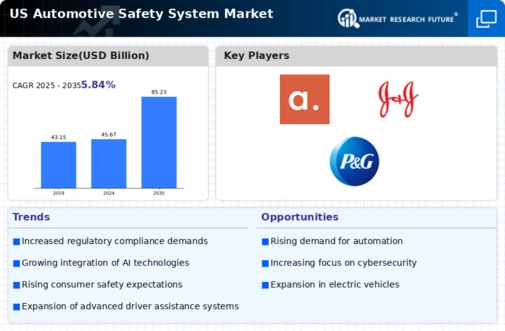Government Initiatives and Funding
Government initiatives aimed at improving road safety are playing a crucial role in the automotive safety-system market. Various federal and state programs are providing funding for research and development of advanced safety technologies. For instance, the National Highway Traffic Safety Administration (NHTSA) has allocated substantial resources to promote the adoption of safety systems in vehicles. This funding is expected to stimulate innovation and accelerate the deployment of safety features across the automotive industry. As a result, the automotive safety-system market will benefit from enhanced collaboration between government entities and manufacturers, fostering a safer driving environment..
Consumer Awareness and Demand for Safety
Consumer awareness regarding vehicle safety has significantly increased, impacting the automotive safety-system market. Surveys indicate that over 70% of potential car buyers prioritize safety features when selecting a vehicle. This heightened awareness is largely driven by media coverage of accidents and safety recalls, prompting consumers to seek vehicles with robust safety systems. Consequently, manufacturers are compelled to enhance their safety offerings to meet consumer expectations. The growing demand for safer vehicles is likely to result in increased investments in safety technologies, thereby propelling the automotive safety-system market forward. This trend suggests that consumer preferences will continue to shape the landscape of automotive safety.
Insurance Incentives for Safety Features
Insurance companies are increasingly offering incentives for vehicles equipped with advanced safety features, which is influencing the automotive safety-system market. Policies that provide discounts for cars with high safety ratings or specific safety technologies are becoming more common. This trend not only encourages consumers to invest in safer vehicles but also motivates manufacturers to prioritize safety in their designs. Data suggests that vehicles with advanced safety systems can reduce insurance premiums by up to 15%. As insurance companies recognize the correlation between safety features and reduced claims, the automotive safety-system market is likely to see a rise in demand for such technologies.
Technological Advancements in Safety Features
There is a surge in technological advancements that enhance vehicle safety in the automotive safety-system market.. Innovations such as automatic emergency braking, lane departure warnings, and adaptive cruise control are becoming standard features in new vehicles. According to recent data, the adoption of these technologies has increased by approximately 30% over the past five years. This trend indicates a growing consumer demand for vehicles equipped with advanced safety features, which is likely to drive the automotive safety-system market further. As manufacturers invest in research and development, the integration of cutting-edge technologies is expected to improve overall vehicle safety ratings, thereby influencing consumer purchasing decisions.
Collaboration Between Automakers and Tech Companies
The automotive safety-system market is witnessing a growing trend of collaboration between traditional automakers and technology companies. This partnership aims to integrate advanced technologies such as artificial intelligence and machine learning into safety systems. By leveraging the expertise of tech firms, automakers can enhance the functionality and effectiveness of their safety features. This collaboration is expected to lead to the development of more sophisticated safety systems that can adapt to various driving conditions. As these partnerships continue to evolve, the automotive safety-system market is likely to experience accelerated growth, driven by innovative solutions that improve vehicle safety.














Leave a Comment